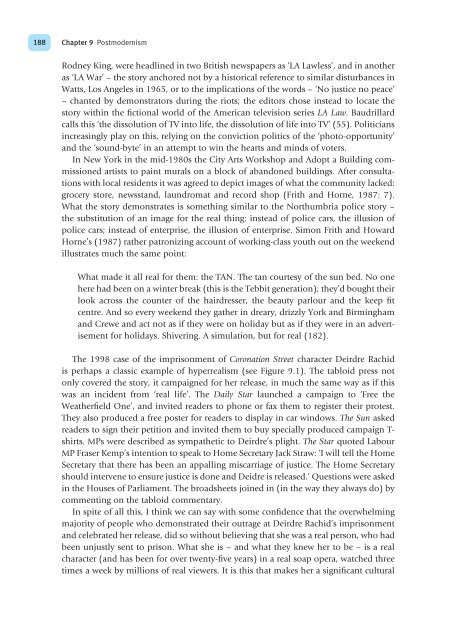Cultural Theory and Popular Culture
Cultural Theory and Popular Culture
Cultural Theory and Popular Culture
Create successful ePaper yourself
Turn your PDF publications into a flip-book with our unique Google optimized e-Paper software.
188<br />
Chapter 9 Postmodernism<br />
Rodney King, were headlined in two British newspapers as ‘LA Lawless’, <strong>and</strong> in another<br />
as ‘LA War’ – the story anchored not by a historical reference to similar disturbances in<br />
Watts, Los Angeles in 1965, or to the implications of the words – ‘No justice no peace’<br />
– chanted by demonstrators during the riots; the editors chose instead to locate the<br />
story within the fictional world of the American television series LA Law. Baudrillard<br />
calls this ‘the dissolution of TV into life, the dissolution of life into TV’ (55). Politicians<br />
increasingly play on this, relying on the conviction politics of the ‘photo-opportunity’<br />
<strong>and</strong> the ‘sound-byte’ in an attempt to win the hearts <strong>and</strong> minds of voters.<br />
In New York in the mid-1980s the City Arts Workshop <strong>and</strong> Adopt a Building commissioned<br />
artists to paint murals on a block of ab<strong>and</strong>oned buildings. After consultations<br />
with local residents it was agreed to depict images of what the community lacked:<br />
grocery store, newsst<strong>and</strong>, laundromat <strong>and</strong> record shop (Frith <strong>and</strong> Horne, 1987: 7).<br />
What the story demonstrates is something similar to the Northumbria police story –<br />
the substitution of an image for the real thing: instead of police cars, the illusion of<br />
police cars; instead of enterprise, the illusion of enterprise. Simon Frith <strong>and</strong> Howard<br />
Horne’s (1987) rather patronizing account of working-class youth out on the weekend<br />
illustrates much the same point:<br />
What made it all real for them: the TAN. The tan courtesy of the sun bed. No one<br />
here had been on a winter break (this is the Tebbit generation); they’d bought their<br />
look across the counter of the hairdresser, the beauty parlour <strong>and</strong> the keep fit<br />
centre. And so every weekend they gather in dreary, drizzly York <strong>and</strong> Birmingham<br />
<strong>and</strong> Crewe <strong>and</strong> act not as if they were on holiday but as if they were in an advertisement<br />
for holidays. Shivering. A simulation, but for real (182).<br />
The 1998 case of the imprisonment of Coronation Street character Deirdre Rachid<br />
is perhaps a classic example of hyperrealism (see Figure 9.1). The tabloid press not<br />
only covered the story, it campaigned for her release, in much the same way as if this<br />
was an incident from ‘real life’. The Daily Star launched a campaign to ‘Free the<br />
Weatherfield One’, <strong>and</strong> invited readers to phone or fax them to register their protest.<br />
They also produced a free poster for readers to display in car windows. The Sun asked<br />
readers to sign their petition <strong>and</strong> invited them to buy specially produced campaign Tshirts.<br />
MPs were described as sympathetic to Deirdre’s plight. The Star quoted Labour<br />
MP Fraser Kemp’s intention to speak to Home Secretary Jack Straw: ‘I will tell the Home<br />
Secretary that there has been an appalling miscarriage of justice. The Home Secretary<br />
should intervene to ensure justice is done <strong>and</strong> Deidre is released.’ Questions were asked<br />
in the Houses of Parliament. The broadsheets joined in (in the way they always do) by<br />
commenting on the tabloid commentary.<br />
In spite of all this, I think we can say with some confidence that the overwhelming<br />
majority of people who demonstrated their outrage at Deirdre Rachid’s imprisonment<br />
<strong>and</strong> celebrated her release, did so without believing that she was a real person, who had<br />
been unjustly sent to prison. What she is – <strong>and</strong> what they knew her to be – is a real<br />
character (<strong>and</strong> has been for over twenty-five years) in a real soap opera, watched three<br />
times a week by millions of real viewers. It is this that makes her a significant cultural
















